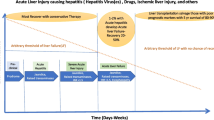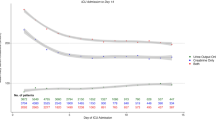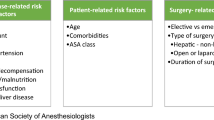Abstract
Purpose
Pyogenic liver abscess (PLA) is a severe disease, which unfavourable evolution remains frequent. Our objective was to assess predictive factors of unfavourable outcome in patients with PLA.
Methods
We conducted a retrospective study in a French tertiary care centre. All patients admitted for PLA between 2010 and 2018 were included. Unfavourable course was defined as the occurrence of a primary treatment failure (PTF), recurrence of PLA after an initial cure, or death within 3 months after diagnosis. Hazard ratios (95% CI) were calculated with multivariable Cox proportional hazard models.
Results
302 patients were included among which 91 (30.1%) patients had an unfavourable outcome because of PTF, recurrence or death in 55 (18.2%), 28 (9.2%) and 32 (10.6%) patients, respectively. Hepatic metastases (HR 2.08; 95% CI 1.04–4.15), a nosocomial infection (2.25; 1.14–4.42), portal thrombosis (2.12; 1.14–3.93), and the isolation of Enterococcus spp. (2.18; 1.22– 3.90) were independently associated with PTF. Ischemic cholangitis (6.30; 2.70–14.70) and the isolation of Streptococcus spp. (3.72; 1.36–10.16) were associated with the risk of recurrence. Charlson comorbidity index (HR 1.30 per one point; 95% CI 1.15–1.46; p < 0.001), portal thrombosis (3.53; 1.65–7.56) and the presence of multi-drug-resistant organisms (3.81; 1.73–8.40) were associated with mortality within 3 months following PLA diagnosis. PLA drainage was the only factor associated with a lower mortality (0.14; 0.06–0.34).
Conclusion
Identification of specific risk factors may help to improve the management of PLA and to elaborate targeted recommendations according to patient’s and disease’s characteristics.


Similar content being viewed by others
References
Ochsner A, DeBakey M, Murray S. Pyogenic abscess of the liver: II. An analysis of forty-seven cases with review of the literature. Am J Surg. 1938;40:292–319.
Meddings L, Myers RP, Hubbard J, Shaheen AA, Laupland KB, Dixon E, et al. A population-based study of pyogenic liver abscesses in the United States: incidence, mortality, and temporal trends. Am J Gastroenterol. 2010;105:117–24.
Kaplan GG, Gregson DB, Laupland KB. Population-based study of the epidemiology of and the risk factors for pyogenic liver abscess. Clin Gastroenterol Hepatol. 2004;2:1032–8.
Jepsen P, Vilstrup H, Schønheyder HC, Sørensen HT. A nationwide study of the incidence and 30-day mortality rate of pyogenic liver abscess in Denmark, 1977–2002. Aliment Pharmacol Ther. 2005;21:1185–8.
Lo JZW, Leow JJJ, Ng PLF, Lee HQ, Mohd Noor NA, Low JK, et al. Predictors of therapy failure in a series of 741 adult pyogenic liver abscesses. J Hepatobiliary Pancreat Sci. 2015;22:156–65.
Wang JH, Liu YC, Lee SS, Yen MY, Chen YS, Wang JH, et al. Primary liver abscess due to Klebsiella pneumoniae in Taiwan. Clin Infect Dis. 1998;26:1434–8.
Siu LK, Yeh K-M, Lin J-C, Fung C-P, Chang F-Y. Klebsiella pneumoniae liver abscess: a new invasive syndrome. Lancet Infect Dis. 2012;12:881–7.
Zhang Y, Zhao C, Wang Q, Wang X, Chen H, Li H, et al. High prevalence of hypervirulent klebsiella pneumoniae infection in china: geographic distribution, clinical characteristics, and antimicrobial resistance. Antimicrob Agents Chemother. 2016;60:6115–20.
Huang CJ, Pitt HA, Lipsett PA, Osterman FA, Lillemoe KD, Cameron JL, et al. Pyogenic hepatic abscess. Changing trends over 42 years. Ann Surg. 1996;223:600–7; discussion 607–609.
Njoku VC, Howard TJ, Shen C, Zyromski NJ, Schmidt CM, Pitt HA, et al. Pyogenic liver abscess following pancreaticoduodenectomy: risk factors, treatment, and long-term outcome. J Gastrointest Surg. 2014;18:922–8.
Tachopoulou OA, Vogt DP, Henderson JM, Baker M, Keys TF. Hepatic abscess after liver transplantation: 1990–2000. Transplantation. 2003;75:79–83.
Czerwonko ME, Huespe P, Elizondo CM, Pekolj J, Gadano A, Barcán L, et al. Risk factors and outcomes of pyogenic liver abscess in adult liver recipients: a matched case-control study. HPB (Oxford). 2018;20:583–90.
Ruiz-Hernández JJ, León-Mazorra M, Conde-Martel A, Marchena-Gómez J, Hemmersbach-Miller M, Betancor-León P. Pyogenic liver abscesses: mortality-related factors. Eur J Gastroenterol Hepatol. 2007;19:853–8.
Alvarez Pérez JA, González JJ, Baldonedo RF, Sanz L, Carreño G, Junco A, et al. Clinical course, treatment, and multivariate analysis of risk factors for pyogenic liver abscess. Am J Surg. 2001;181:177–86.
Bamberger DM. Outcome of medical treatment of bacterial abscesses without therapeutic drainage: review of cases reported in the literature. Clin Infect Dis. 1996;23:592–603.
Cai Y-L, Xiong X-Z, Lu J, Cheng Y, Yang C, Lin Y-X, et al. Percutaneous needle aspiration versus catheter drainage in the management of liver abscess: a systematic review and meta-analysis. HPB (Oxford). 2015;17:195–201.
Quan H, Li B, Couris CM, Fushimi K, Graham P, Hider P, et al. Updating and validating the Charlson comorbidity index and score for risk adjustment in hospital discharge abstracts using data from 6 countries. Am J Epidemiol. 2011;173:676–82.
Healthcare-associated infections [Internet]. European Centre for Disease Prevention and Control. [cited 2022 Feb 11]. https://www.ecdc.europa.eu/en/healthcare-associated-infections
CASFM / EUCAST V1.1 Avril 2020 [Internet]. Société Française de Microbiologie. 2020 [cited 2021 Jan 8]. https://www.sfm-microbiologie.org/2020/04/07/casfm-eucast-v1-0-avril-2020/
Leclercq R, Cantón R, Brown DFJ, Giske CG, Heisig P, MacGowan AP, et al. EUCAST expert rules in antimicrobial susceptibility testing. Clin Microbiol Infect. 2013;19:141–60.
Magiorakos A-P, Srinivasan A, Carey RB, Carmeli Y, Falagas ME, Giske CG, et al. Multidrug-resistant, extensively drug-resistant and pandrug-resistant bacteria: an international expert proposal for interim standard definitions for acquired resistance. Clin Microbiol Infect. 2012;18:268–81.
Mücke MM, Kessel J, Mücke VT, Schwarzkopf K, Hogardt M, Stephan C, et al. The role of Enterococcus spp. and multidrug-resistant bacteria causing pyogenic liver abscesses. BMC Infect Dis. 2017;17:1–10.
Rossi B, Gasperini ML, Leflon-Guibout V, Gioanni A, de Lastours V, Rossi G, et al. Hypervirulent Klebsiella pneumoniae in Cryptogenic Liver Abscesses, Paris. France Emerging Infect Dis. 2018;24:221–9.
Serraino C, Elia C, Bracco C, Rinaldi G, Pomero F, Silvestri A, et al. Characteristics and management of pyogenic liver abscess: A European experience. Medicine (Baltimore). 2018;97:e0628.
Neill L, Edwards F, Collin SM, Harrington D, Wakerley D, Rao GG, et al. Clinical characteristics and treatment outcomes in a cohort of patients with pyogenic and amoebic liver abscess. BMC Infect Dis. 2019;19:490.
Rahimian J, Wilson T, Oram V, Holzman RS. Pyogenic liver abscess: recent trends in etiology and mortality. Clin Infect Dis. 2004;39:1654–9.
Czerwonko ME, Huespe P, Bertone S, Pellegrini P, Mazza O, Pekolj J, et al. Pyogenic liver abscess: current status and predictive factors for recurrence and mortality of first episodes. HPB (Oxford). 2016;18:1023–30.
Cheng H-C, Chang W-L, Chen W-Y, Kao A-W, Chuang C-H, Sheu B-S. Long-term outcome of pyogenic liver abscess: factors related with abscess recurrence. J Clin Gastroenterol. 2008;42:1110–5.
Lafont E, Roux O, de Lastours V, Dokmak S, Leflon V, Fantin B, et al. Pyogenic liver abscess in liver transplant recipient: a warning signal for the risk of recurrence and retransplantation. Transpl Infect Dis. 2020;e13360.
Große K, Ohm D, Würstle S, Brozat JF, Schmid RM, Trautwein C, et al. Clinical characteristics and outcome of patients with enterococcal liver abscess. Sci Rep. 2021;11:22265.
Syed MA, Kim TK, Jang H-J. Portal and hepatic vein thrombosis in liver abscess: CT findings. Eur J Radiol. 2007;61:513–9.
Molton JS, Chee YL, Hennedige TP, Venkatesh SK, Archuleta S. Impact of Regional Vein Thrombosis in Patients with Klebsiella pneumoniae Liver Abscess. PLoS ONE. 2015;10:e0140129.
Alsaif HS, Venkatesh SK, Chan DSG, Archuleta S. CT appearance of pyogenic liver abscesses caused by Klebsiella pneumoniae. Radiology. 2011;260:129–38.
Acknowledgements
We thank Roza Rahli for her contribution to data entry, and Victoire de Lastours for reviewing the English text.
Funding
No external funding was received.
Author information
Authors and Affiliations
Contributions
Study conception and design: RG, LA. Acquisition of data: RG, LE, CE, RB, RO, DS, BF, LA, FB Analysis and interpretation of data: RG, NY, LA Drafting and writing of the manuscript: RG, LA All authors were involved in revising the manuscript, and all authors approved the final version to be published. AL and GR have full access to all the data and take responsibility for the integrity of the data and the accuracy of the data analyses.
Corresponding authors
Ethics declarations
Conflict of interests
All authors have declared no conflicts of interest related to this work.
Supplementary Information
Below is the link to the electronic supplementary material.
Rights and permissions
About this article
Cite this article
Rossi, G., Nguyen, Y., Lafont, E. et al. Large retrospective study analysing predictive factors of primary treatment failure, recurrence and death in pyogenic liver abscesses. Infection 50, 1205–1215 (2022). https://doi.org/10.1007/s15010-022-01793-z
Received:
Accepted:
Published:
Issue Date:
DOI: https://doi.org/10.1007/s15010-022-01793-z




